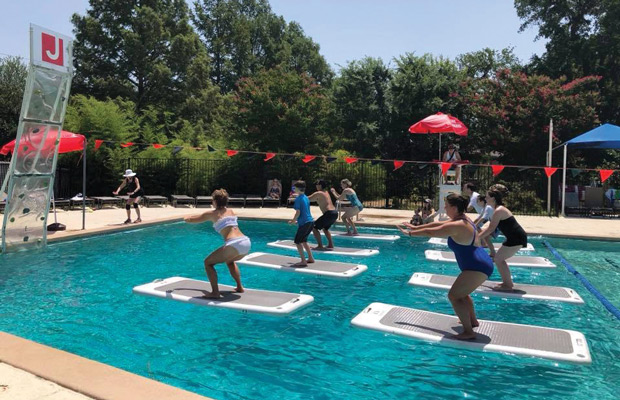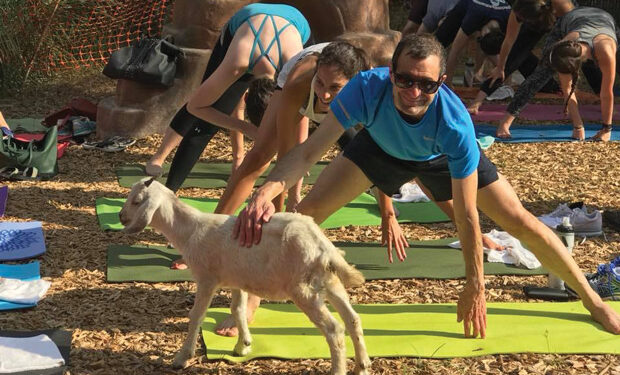The fitness industry is constantly changing, with new technology and exercise classes surfacing regularly. It’s imperative for community rec centers to keep pace with these trends and meet the needs of their members, or better yet, stick out from the competition.
Because technology continues to be at the forefront of exercise trends, industry leaders are constantly trying new ideas to stay ahead of the game. “If I’ve been doing it for more than two years, it’s not a trend anymore,” said Terri Arends, the group fitness director at the Jewish Community Center of Dallas. “I’m always looking for how you can take something that’s out there and progress it forward.”

According to Arends, the fitness industry can be compared to the entertainment industry. “You have to keep changing it up and progressing forward to keep everyone entertained and coming back,” she said.
One of the ways Arends does this is incorporating leaderboard systems and app-controlled lighting. She encourages members to download Spivi, which when paired with a heart rate monitor, gives members performance data and leaderboard stats.
“By having the leaderboard system, you get results that follow you home,” said Arends. “It’s really motivating, and people appreciate this extra bit of information so they can get real results – technology delivers results.”
Technology is able to deliver another fitness trend: on-demand content. “Facilities like ours, that have a shortage of qualified group exercise instructors, can really maximize on vendors to supplement our core live offerings,” said Art Krueger, the director of The Wave Aquatic & Fitness Center. “As the technology improves and video production quality increases, I see this as a major impact.”
Krueger elaborated the community likes on-demand content because it can be done anywhere, anytime — however, members still love in-person experiences due to the social component. “The power of tribalism is undeniable and has become an essential part of programming through small group offerings,” he said.

In conjunction with technology, an evolving trend is dedicated spaces for small group training. Community rec centers have been in competition with the sudden influx of boutique studios offering specialized classes.
Arends made sure her JCC didn’t fall behind. “There are no more multipurpose rooms where you roll the bikes out,” she said. “I’ve created spaces that are specifically designed for particularly formatted classes — the environment is an important key to the space.”
A trending dedicated space the Dallas JCC offers is a Speedflex studio, an interval workout using hydraulic equipment for only 27 minutes. “It’s a great workout because everybody is so time-oriented these days and in 27 minutes, you’re done and you’ve had a total-body workout, fusing together your cardiovascular and functional strength component to create a really efficient workout,” explained Arends.
Krueger noted it’s imperative to have dedicated spaces within his facility. “They give a sense of home for the trainers and coaches, as well as the participants,” he explained. “They also help avoid disruption on the fitness floor.”
While spaces for specific modalities are trending, so are the unique classes that fill them. Members crave change and variety, so Arends changes class schedules quarterly and hosts special seasonal events. “I’m constantly putting together things that are off the beaten path and beyond the normal regular programming,” she said.
During seasonal classes such as goat yoga, they allow non-members to participate, increasing brand awareness and membership numbers.
According to Arends, a popular trend involves multiple avenues of yoga. “In addition to yoga, another discipline that seems to be transporting itself to the front of the line is meditation,” she said.

As a result, Arends designed a boutique-style class called “Sound Float.” Participants float in a warm pool, supported, while hearing music and being guided through a mediation. Below water, a high-tech speaker plays music, sending vibrations through the water.
Facilities also need to keep in mind the ongoing demand for functional training space and equipment. “Space for traditional selectorized [equipment] and free weights is essential, but so is having space to utilize functional training,” said Krueger. “I see this as the norm in facilities, as the consumer of today is much more knowledgeable than ever before and has this type of exercise in their routines almost without fail.”
Arends and Krueger have found success in using functional equipment like Precor’s Queenax. Arends called Queenax “the mother of all functional fitness frames,” because of how easy it is to use and adjust.
When thinking about the future of the industry, Arends believes technology will be the key to staying ahead of trends. “I predict that prototypes will be rectified and out on the market, such as immersive virtual reality types of applications,” she said. “Whether it be on cardio equipment in your fitness area, or specifically organized for a group class – it’s coming, it’s already out there and it will be perfected.”
The easiest way to stay on top of trends is to research and try. “Never be complacent – always look to see what’s out there and what you can create for your facility that’s going to be a little different than your competitors,” encouraged Arends. “Sometimes when you try things, there are a lot of different moving parts, and if it doesn’t work out 100 percent, it’s OK to fail then regroup – that’s the way things move forward.”










